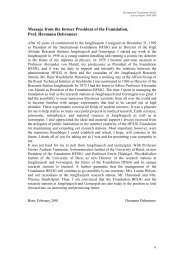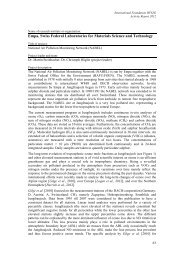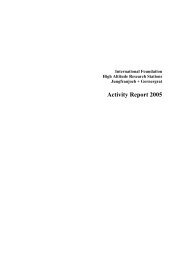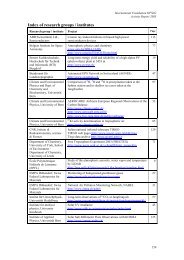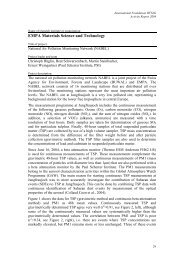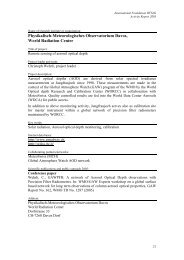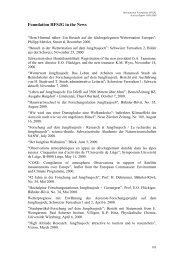Cosmic ray induced failures in biased power semiconductor devices
Cosmic ray induced failures in biased power semiconductor devices
Cosmic ray induced failures in biased power semiconductor devices
You also want an ePaper? Increase the reach of your titles
YUMPU automatically turns print PDFs into web optimized ePapers that Google loves.
International Foundation HFSJG<br />
Activity Report 2002<br />
Name of research <strong>in</strong>stitute or organization:<br />
ABB Switzerland Ltd, Semiconductors<br />
Title of project:<br />
<strong>Cosmic</strong> <strong>ray</strong> <strong><strong>in</strong>duced</strong> <strong>failures</strong> <strong>in</strong> <strong>biased</strong> high <strong>power</strong> <strong>semiconductor</strong> <strong>devices</strong><br />
Project leader and team:<br />
Charles F<strong>in</strong>deisen, project leader<br />
Thomas Stiasny, Hansruedi Zeller<br />
Project description:<br />
Biased high <strong>power</strong> <strong>semiconductor</strong> <strong>devices</strong> like diodes, thyristors or IGBTs might fail<br />
suddenly without any previous device wear-out or electrical overload condition. This<br />
phenomenon is expla<strong>in</strong>ed by cosmic <strong>ray</strong>s where one particle triggers <strong>in</strong>side the <strong>biased</strong><br />
silicon bulk a localized breakdown event, f<strong>in</strong>ally destroy<strong>in</strong>g the <strong>devices</strong> [1-4].<br />
Accelerated tests reduc<strong>in</strong>g costs and time are feasible at locations with enhanced<br />
cosmic <strong>ray</strong> fluxes (e.g. at Jungfraujoch) or with particle beams.<br />
The test setup was located on a platform (area 0.7 m 2 ) just below a wooden roof of<br />
the Sph<strong>in</strong>x observatory. About 10 to 500 <strong>devices</strong> of one or two different types or<br />
designs were tested <strong>in</strong> parallel. Failed <strong>devices</strong> due to cosmic <strong>ray</strong>s were identified by<br />
observ<strong>in</strong>g a constant leakage current until the occurance of the failure and by<br />
characteristic defects like small spots somewhere on the silicon chip [5,6]. The<br />
measured failure rates and the characteristic defects of the chips depended on the<br />
device types and the applied biases but were <strong>in</strong> first order <strong>in</strong>dependend on the<br />
<strong>in</strong>cident particle type (neutron or proton beams and cosmics).<br />
The sharp drop of the failure rates below a characteristic bias U c was observed for all<br />
device types but so far only with proton and neutron beams (Fig. 1). The poor<br />
statistics with cosmic tests did not allow to reproduce this drop-off. The predictions<br />
for most of the device types were <strong>in</strong> fair agreement with the test results except for the<br />
sharp drop of the failure rates [4].<br />
The biases for typical device applications are normally below U c . The capital goods<br />
<strong>in</strong>dustry demands that the failure rates of <strong>power</strong> <strong>devices</strong> due to cosmics are smaller<br />
than one failure every 10 9 hour and every 1 cm 2 device area. Thus it is of vital <strong>in</strong>terest<br />
to know if the failure rates due to cosmics exhibit a similar drop-off behaviour similar<br />
to those due to neutron or proton beams.<br />
In 2002 a test sequence with an <strong>in</strong>creased number of <strong>devices</strong> was started to clarify the<br />
possible drop of the failure rates due to cosmics below U c . It will cont<strong>in</strong>ue <strong>in</strong> 2003.<br />
Glossary<br />
IGBT: Insulated Gate Bipolar Transistor; voltage controlled <strong>power</strong> transistor.<br />
References<br />
[1] H. Kabza et al., Proc IEEE Intern. Symp. Power Semicond. Devices and ICs,<br />
Davos, pp. 9-12, 1994<br />
[2] H.R. Zeller, Proc IEEE Intern. Symp.Power Semicond. Devices and ICs, Davos,<br />
pp. 339-340, 1994<br />
H.R. Zeller, Solid State Electronics, 38, No.12, 2041-2046, (1995)<br />
85
International Foundation HFSJG<br />
Activity Report 2002<br />
[3] P. Voss et al., Proc IEEE Intern. Symp. Power Semicond. Devices and ICs,<br />
Weimar, pp. 169-172, 1997<br />
[4] H.R. Zeller, Microelectron. Reliab., Vol. 37, No. 10/11, pp. 1711-1718, 1997<br />
[5] Ch. F<strong>in</strong>deisen et al., Microelectron. Reliab., Vol. 38 (1998), pp. 1335-1339<br />
[6] Ch. F<strong>in</strong>deisen et al., Annual report of the Foundation HFSJG, 1998, 2000, 2001<br />
1.E+05<br />
1.E+04<br />
IGBT<br />
cosmics<br />
failure rate [FIT/cm 2 ]<br />
1.E+03<br />
1.E+02<br />
1.E+01<br />
protons (PIF)<br />
neutrons<br />
(LANSCE)<br />
1.E+00<br />
ABB Switzerland Ltd<br />
Semiconductors<br />
prediction<br />
1.E-01<br />
1200 1400 1600 1800 2000<br />
block<strong>in</strong>g bias (V)<br />
Fig. 1: Failure rates of a certa<strong>in</strong> IGBT device due to cosmics, protons (PSI-PIF, 300<br />
MeV) and neutrons (LANSCE, energy spectrum proportional to 1/E and with E < 800<br />
MeV). Here the application bias was well below the characteristic bias U c = 1500 V.<br />
All failure rates were normalized to New York City and to a temperature of 25 °C.<br />
One FIT/cm 2 corresponded to one failed chip every 10 9 chip⋅hour normalized to one<br />
cm 2 silicon area.<br />
Key words:<br />
cosmics, <strong>power</strong> <strong>semiconductor</strong> <strong>devices</strong>, <strong>failures</strong><br />
Internet data bases:<br />
Collaborat<strong>in</strong>g partners/networks:<br />
Scientific publications and public outreach 2002:<br />
86
International Foundation HFSJG<br />
Activity Report 2002<br />
Address:<br />
ABB Switzerland Ltd<br />
Semiconductors<br />
Fabrikstrasse 3<br />
CH-5600 Lenzburg<br />
Contacts:<br />
Thomas Stiasny<br />
Tel.: +41 58 58 61 314<br />
Fax: +41 58 58 61 305<br />
e-mail: thomas.stiasny@ch.abb.com<br />
87
International Foundation HFSJG<br />
Activity Report 2002<br />
88


